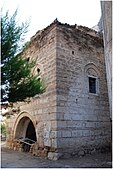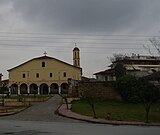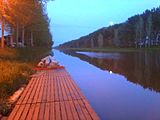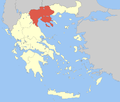Giannitsa
The municipal unit Giannitsa has an area of 208.105 km. Its population is 32,410 people (2021 census). It includes a few outlying villages (Mesiano, Melissi, Pentaplatanos, Archontiko, Ampelies and Damiano). The municipality Pella as a whole includes many villages and has 57,039 inhabitants. The city is located in the center of Macedonia between Mount Paiko and the plain of Giannitsa, and is the economic, commercial and industrial center of the Pella regional unit. European route E86 (Greek National Road 2) runs along the south of the city.
The former shallow, swampy, and variable-sized Giannitsa Lake or (ancient) Loudias Lake, fed by the Loudias River and south of the city, was drained in 1928-1932 by the New York Foundation Company. It or the surrounding marshland were sometimes called Borboros 'slime' or Borboros Limen.
About 7 km (4 mi) from Giannitsa are the ruins of ancient Pella, birthplace of Alexander the Great and capital of ancient Macedonia. The city is 48 km (30 mi) from Thessaloniki.
Name

The city was founded as Yenice-i Vardar Ottoman Turkish يڭيجۀ واردار 'new (town) of Vardar' in around 1383 – 1387. It was sometimes called Evrenos Beg yöresi 'Evrenos Bey's town'.
The Turkish name, in the form Yenitsa (Γενιτσά), was used until February 1926 when its name was Hellenized as Giannitsa (Γιαννιτσά). In other languages, the city is called: Ottoman Turkish Yenice-i Vardar ('new-town of Vardar', as opposed to Yenice-i Karasu, modern Genisea, near Xanthi and known for tobacco), Turkish Yenice or Vardar Yenicesi, Bulgarian: Енидже Вардар, Enidzhe Vardar or Пазар Pazar, Macedonian: Ениџе Вардар, Enidzhe Vardar.
Population
| Year | Population |
|---|---|
| 2021 | 30,498 |
| 2011 | 29,789 |
| 2001 | 29,364 |
| 1991 | 22,504 |
| 1981 | 23,966 |
| 1971 | 21,188 |
| 1961 | 19,693 |
| 1951 | 16,640 |
| 1940 | 12,964 |
| 1928 | 9,128 |
| 1913 | 7,167 |
History
Prehistoric
In the area of "Old Market", on the southern hill of the city, there was an Early Neolithic settlement (late 7th to early 6th millennium BC). Giannitsa was also inhabited through the Bronze and Iron Ages. Incidental findings, such as coins, inscriptions, and sculptures indicate that the area was inhabited during the Hellenistic period (323-30BC). In ancient times, the area was called Bottiaea. In the vicinity of the city ancient towns of Pella and Kyrros and medieval metropolitan centre of Giannitsa were presented.
Ottoman

Though there was probably a pre-existing Byzantine castle in the vicinity, the importance of the city of Giannitsa begins with its foundation by Gazi Evrenos in around 1383 – 1387. Giannitsa became the base of the ghazi followers of Evrenos who took Macedonia and later Albania. The city (known as Vardar Yenicesi or Yenice-i Vardar under the Ottomans) was an important Ottoman cultural center and sacred area in the 15th and 16th centuries. Starting in the mid-15th century, Giannitsa became a center of literature and the arts. Under Ahmet Bey, a descendant of Gazi Evrenos, many mosques, schools, workhouses and charitable projects were founded. In 1519 (Hijri 925), its population consisted of 793 Muslim, 25 Christian and 24 Jewish households and it was a zeamet of Mevlana Ahmet Çelebi.
Although Persian was widely studied in the Ottoman-held Balkans (Rumelia), Vardar Yenicesi differed from other localities in the Balkans insofar as that it was a town where Persian was also widely spoken. However, the Persian of Vardar Yenicesi and throughout the rest of the Ottoman-held Balkans was different from formal Persian both in accent and vocabulary. The difference was apparent to such a degree that the Ottomans referred to it as "Rumelian Persian" (Rumili Farsisi). As learned people such as students, scholars and literati often frequented Vardar Yenicesi, it soon became the site of a flourishing Persianate linguistic and literary culture. The 16th-century Ottoman Aşık Çelebi (died 1572), who hailed from Prizren in modern-day Kosovo, was galvanized by the abundant Persian-speaking and Persian-writing communities of Vardar Yenicesi, and he referred to the city as a "hotbed of Persian".
In the early 20th century, Giannitsa was a battleground between Bulgarian and Greek partisans in the Macedonian struggle. Penelope Delta's novel Secrets of the Swamp (referring to the shores of Giannitsa Lake) is a romanticised account of this from the Greek point of view.

Balkan wars

Giannitsa "retained its emphatically Turkish character up to 1912" and members of the Evrenos family lived in the city in a large palace in the center of town until then. In the First Balkan War, the Battle of Giannitsa (20 October 1912) was one of the most important battles the Hellenic Army fought.
German occupation
The German army invaded Giannitsa on April 11, 1941 . On April 20, 1941, some Austrian forces arrived. The municipal registry of Giannitsa confirms four random killings in various parts of the city. On 16 September 1943, the Municipality of Giannitsa, headed by the Mayor, Thomas Magriotis and the help of local soccer teams organized a demonstration in the city and indulge in German commandant a text against the intention of the Germans to surrender Central Macedonia to the Bulgarians. According to oral testimony on November 13, 1943, the Germans arrested around 50 people, whom they transferred to the camp of Pavlos Melas at Thessaloniki and they killed thirteen. At the same time, the Germans invaded for the first time the village Eleftherohori 7 km (4 mi) away from the city, steal and destroy. In this attack there were no casualties. On 23 March 1944, the village was burned, and the place deserted. Eleftherohori lost 19 lives. On 5 August 1944, the Austrian soldier Otmar Dorne left the German occupation army and joined the 30th Constitution of the E.L.A.S, based in Mount Paiko. The defection of Dorne, and the presence of the Wehrmacht sergeant Schubert, led to mass reprisals on 14 September 1944 in Giannitsa: about 120 residents of Giannitsa were executed by forces of the Jagdkommando Schubert with the collaboration of Greek units under the command of G. Poulos. Among those executed was the Mayor, Thomas Mangriotis. The Swedish ambassador Timberg indicated that one third of the city was destroyed by fire. The citizens left the city. Emile Wenger visited Giannitsa few days after the mass execution, as a representative of the International Red Cross and wrote "Giannitsa is already a dead city". On 20 September 1944, a citizens' committee sent a message to the National Government stating the facts and asking for weapons. The Germans left Giannitsa on November 3, 1944.
During this period in the city is formed Bulgarian action committee and later Central Bulgarian-macedonian committee, headed by the local citizen Georgi Kayafov. Also a Thessaloniki bulgarian club branch was formed by locals Georgi Yankulov, Perikle Gyupchinov, Hristo Panayotov and Georgi Kayafov.
Landmarks
Monuments

Giannitsa was an important center in the Ottoman period, and several important monuments survive, such as the Tombs of Gazi Evrenos (built in 1417) and Gazi Ahmed Bey, the Kaifoun Baths, the Great Mosque, the Army Mosque, the hammam of Evrenos, and the Clock Tower, built from 1667 to 1668 by the Ottomans. (The choice of location was made with military criteria because they wanted to control the commercial activity that took place across the city and throughout central Macedonia.) These monuments have been declared historical monuments by the Greek Archaeological Service.
Points of interest include also the Cathedral Church of Giannitsa (achieved in 1860), the Neoclassical Multicenter, the Filippeio tourist center, the Macedonian tombs, and the prehistoric settlement of Archontiko.

Museums
- The Folklore Museum of Giannitsa (opened in October 1977) by the "Philippos" History and Folklore Association to promote local history and traditions.
- The Military museum of Giannitsa (opened 24 February 2012), displays photographs, texts, weapons, uniforms, medals and other materials, with a particular emphasis on the Battle of the Swamp and the Balkan Wars 1912–1913.
Statues

- Black Statue - The Memorial of Giannitsà, erected at the eastern entrance to the town in 1926 in honor and remembrance of the battle of Giannitsà (Sculptor: Gregory Zevgolis).
- Mass Grave, a list of the residents who were executed at the 1st Primary School on 14 September 1944 by German troops.
- Alexander the Great, near the Cultural Center, unveiled on 20 October 2009, the anniversary of the liberation of the city and the Day of the Macedonian Struggle.
- Philip II of Macedon, located in the park of the "Filippio" tourist center. Near the statue, there is a relief depicting the Macedonian phalanx.
- A bust of the Makedonomachos Gonos Yiotas in Gonou Yiota Square.
Aravissos

About 10 km (6 mi) northwest of the city is the spring of Aravissos, which produces drinking water. The surrounding grove and creek include a popular park.
Economy
Giannitsa is predominantly a rural area. The draining of the Lake Giannitsà left fertile soil for agriculture, leading to population growth in the region.
Entertainment

The focus of the social life of the city is at the central pedestrian street, where people gather to eat and drink or to take a walk. Giannitsa was one of the first cities that founded Open Theatre (3000 seats) and became an institution for cultural events and big names in theater and music, every year, the last month of summer giving a culture festival character . Also various theatrical and musical events take place in a closed theater located internally of the Cultural Centre which has a modern architecture. In the first days of September there is a big market for about a week. The DI. K. E. P. A. P. (ΔΗ. Κ. Ε. Π. Α. Π) is a charitable non-profit cultural organization founded in 1996 that develops music, visual arts, dance, film and other arts.
Loudias river
Seven kilometers (4.3 miles) south of the center is the Loudias River, which has a sailing center. The Nautical Club of Giannitsa (NOG) teaches canoeing, kayaking, and rowing.
Districts


- Center
- St. George
- Ayía Paraskeví
- Sfageia
- Sinoikismos
- Mitropoli
- St. Konstantinos
- Tsali (Nea Trapezounta)
- Filippeio
- Kapsali
- Palaia agora
Local media

Newspapers
TV station
Online newspapers
- Pella24
- Pellanet
- Giannitsa City news
- Logos Pellas
Sports
The most popular team is the Anagennisi Giannitsa football team which plays at the Municipal Stadium.
There is a motocross track northwest of the city, in the foothills of Mount Paiko, where local, Greek, and European races are run.
At the river Loudias, there are rowing races in which the Nautical Club participates.
Twin towns and sister cities
Giannitsa is twinned with three cities:
 Larnaca, Cyprus, since 2003
Larnaca, Cyprus, since 2003 Crotone, Italy, since 2010
Crotone, Italy, since 2010 New Britain, Connecticut, United States, since 2010
New Britain, Connecticut, United States, since 2010
Notable people
- Gazi Evrenos (died 1417), founder of the Ottoman city, whose mausoleum is in the center of town
- Yakup Ağa, Ottoman soldier and Sipahi, took part in the capture of Lesbos from the Genoese
- Hayreddin Barbarossa (1478-1546) his father Yakup Ağa is from Giannitsa, was appointed Kapudan Pasha (Grand admiral) of the Ottoman Navy by Suleiman the Magnificent
- K̲h̲ayālī (died 1556), Ottoman poet
- Āgehī (died 1577), Ottoman poet and historian
- Georgios 'Gonos' Giotas (1880–1911), revolutionary in the Macedonian Struggle
- Ahmet Derviş (1883–1932), military officer in the Ottoman and Turkish armies
- Sotirios Gotzamanis (1884-1958), physician and National Reform Party politician, accused of treason
- Ioannis Kourkourikis (born 1971), Greek Olympic rower
- Theofilos Karasavvidis (born 1971), former soccer player
- Melina Aslanidou (born 1974), singer born in Germany, but raised in Giannitsa
- Elisavet Mystakidou (born 1977), Greek Olympic silver medalist in taekwondo
- Monsieur Minimal (born 1980), indie pop music composer
- Effie Achtsioglou (born 1985), SYRIZA politician
- Dimitrios Karadolamis (born 1987), basketball player for OFI Crete
- Andreas Varsakopoulos (born 1990), Television personality, personal trainer, Lecturer currently living in South Korea
- Dimitris Pelkas (born 1993), soccer player playing as an attacking midfielder for İstanbul Başakşehir
- Alexandros Varitimiadis (1994-2023), basketball player for Raiffeisen Dornbirn Lions
- Ioanna Chamalidou (born 1996), soccer player playing as a forward for Panathinaikos
- Giannis Michailidis (born 2000), soccer player playing as a centre-back for PAOK
Gallery
References
- ^ "Αποτελέσματα Απογραφής Πληθυσμού - Κατοικιών 2021, Μόνιμος Πληθυσμός κατά οικισμό" [Results of the 2021 Population - Housing Census, Permanent population by settlement] (in Greek). Hellenic Statistical Authority. 29 March 2024.
- ^ "ΦΕΚ A 87/2010, Kallikratis reform law text" (in Greek). Government Gazette.
- ^ "Population & housing census 2001 (incl. area and average elevation)" (PDF) (in Greek). National Statistical Service of Greece. Archived from the original (PDF) on 2015-09-21.
- ^ Eugene N. Borza, In the shadow of Olympus: the emergence of Macedon (1992) ISBN 0-691-00880-9, p. 289; Matthieu Ghilardi et al., "Human occupation and geomorphological evolution of the Thessaloniki Plain (Greece) since mid Holocene", Journal of Archaeological Science 35:1:111-125 (January 2008)
- ^ Ghilardi; Théophile Alphonse Desdevises-du-Dezert, Géographie ancienne de la Macédoine (A. Durand, 1863)
- ^ "Macedonia - Perfecture [sic] of Pella". Archived from the original on 4 March 2016. Retrieved 13 January 2016.
- ^ M. Kiel, „Yenice-i Vardar. A forgotten Turkish cultural center in Macedonia of the 15th and 16th century“, Studia Byzantina et Neohellenica Neerlandica 3 (1971): 311 – 316.
- ^ Encyclopedia of Islam, 2nd edition, s.v. Ewrenos
- ^ Institute for Neohellenic Research, "Name Changes of Settlements in Greece" Genitsa/Giannitsa
- ^ Anastassios Hadjicrystallis - Consultant and developer of Internet and cell phone technology services. "Εργαστήριο Δημογραφικών και Κοινωνικών Αναλύσεων Πανεπιστημίου Θεσσαλίας - Εργο e-Demography - Εκδόσεις ΕΛΣΤΑΤ - Απογραφές - 1928". Retrieved 13 January 2016.
- ^ "Ο ΝΕΟΛΙΘΙΚΟΣ ΟΙΚΙΣΜΟΣ ΤΩΝ ΓΙΑΝΝΙΤΣΩΝ". Retrieved 13 January 2016.
- ^ Христосков, Радослав (2019). "Крепостите на Енидже Вардар в пътеписа на Евлия Челеби – "просто легенда" или наследство от Античността и Средновековието". „Македонски преглед“. XLІI (1). София: МНИ: 41–42, 44, 47–48.
- ^ "Ιστορία Γιαννιτσών". PellaNet Online. Retrieved 13 January 2016.
- ^ GÖKBİLGİN, M. TAYYİB (1956). "KANUNÎ SULTAN SÜLEYMAN DEVRİ BAŞLARINDA RUMELİ EYALETİ, LİVALARI, ŞEHİR VE KASABALARI". Belleten. 20 (78): 264. eISSN 2791-6472. ISSN 0041-4255.
- ^ Inan, Murat Umut (2019). "Imperial Ambitions, Mystical Aspirations: Persian learning in the Ottoman World". In Green, Nile (ed.). The Persianate World The Frontiers of a Eurasian Lingua Franca. University of California Press. p. 86.
- ^ Roudometof, Victor (2002). Collective Memory, National Identity, and Ethnic Conflict: Greece, Bulgaria, and the Macedonian Question. Greenwood Publishing Group. p. 82. ISBN 978-0-275-97648-4.
- ^ Vasilis Demetriades, "The Tomb of Ghāzī Evrenos Bey at Yenitsa and Its Inscription", Bulletin of the School of Oriental and African Studies (University of London) 39 (1976), 2: 328–332; Eleni Kanetaki, "The Still Existing Ottoman Hamams in the Greek Territory", Middle East Technical University Journal of the Faculty of Architecture 21 (2005), 1-2: 81–110, citing M. Kiel, "Yenice-i Vardar. A forgotten Turkish cultural center in Macedonia of the 15th and 16th century", Studia Byzantina et Neohellenica Neerlandica 3 (1971): 300–329.
- ^ "24grammata.com Culture e-Magazine – Free eBooks – WebRadio » Τα Γιαννιτσά στα χρόνια της κατοχής / Eλευθεροχώρι, 23 Μαρτίου 1944". Retrieved 13 January 2016.
- ^ Мичев, Добрин. Българските акционни комитети в Македония – 1941 г., МНИ, София, 1995, с.44
- ^ Даскалов, Георги. Участта на българите в Егейска Македония, 1936 – 1946, Политическа и военна история, София, 1999, с.279
- ^ Мичев, Добрин. Българското национално дело в Югозападна Македония (1941 – 1944 г.)
- ^ Христосков, Радослав (2019). "Националните борби на българите в Енидже Вардар и гръцкият гнет (по спомени на Георги Каяфов)". „Македонски преглед“. XLІI (3). София: МНИ: 133–150.
- ^ ioakim-makedonas (macedonian) (20 October 2009). "Macedonian News M-N Μακεδονικά Νέα". Retrieved 13 January 2016.
- ^ "History - Nautical Club of Giannitsa". Archived from the original on 2014-03-24. Retrieved 2014-03-24.
- ^ "Αδελφοποιήσεις". Archived from the original on 2018-08-14. Retrieved 2019-01-19.
- ^ Grecia e Magna Grecia: incontro Giannitsa e Crotone Archived 2013-11-12 at the Wayback Machine(in Italian)
- ^ "- - - CTNow.com". Archived from the original on 24 December 2013. Retrieved 13 January 2016.
External links
- Δήμος Πέλλας, official site of the municipality of Pella
- Google Earth view of Giannitsa and the drained lakebed












